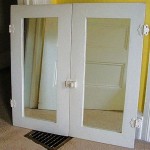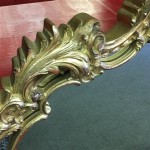Can You Get Spray Paint Off a Mirror? A Comprehensive Guide
Spray paint mishaps happen. Whether an accidental overspray during a DIY project or an unexpected act of vandalism, finding spray paint on a mirror can be frustrating. Fortunately, removing spray paint from a mirror is often achievable without causing permanent damage, provided the correct techniques and tools are employed. This article details multiple methods for safely and effectively removing spray paint from mirrors, considering the type of paint, the duration it has been on the surface, and the potential risks involved.
Before proceeding with any cleaning method, it is crucial to identify the type of spray paint involved. Acrylic, enamel, and lacquer-based paints respond differently to various solvents and removal techniques. Understanding the paint composition allows for the selection of the most appropriate and effective cleaning agent. Attempting to remove spray paint with a mismatched solvent can spread the paint, damage the mirror surface, or create a more significant problem.
The age of the spray paint also significantly impacts the removal process. Freshly applied spray paint is generally easier to remove than paint that has had time to cure and bond to the mirror surface. Fresh paint often responds well to gentler cleaning methods, reducing the risk of scratches or damage. Older, more stubborn paint may require stronger solvents and more aggressive techniques.
Key Point 1: Initial Assessment and Preparation
The first step in removing spray paint from a mirror is a thorough assessment of the situation. This includes identifying the type of spray paint, determining how long it has been on the mirror, and evaluating the extent of the affected area. Proper preparation is critical for achieving successful results and minimizing the potential for damage.
Begin by gathering the necessary supplies. These may include: soft microfiber cloths, plastic razor blades or scrapers, appropriate solvents (such as mineral spirits, acetone, or lacquer thinner), dish soap, warm water, paper towels, safety glasses, and gloves. The choice of solvent depends on the type of spray paint and should be used cautiously to avoid damaging the mirror's reflective coating.
Before applying any solvent to the entire affected area, test it on a small, inconspicuous section of the mirror. This test helps determine if the solvent will damage the mirror's surface or reflective backing. Apply a small amount of the solvent to a cotton swab and gently rub it on the test area. Observe the area for any signs of discoloration, etching, or damage. If no adverse effects are observed after a few minutes, proceed with caution to the larger area.
Protect the surrounding areas to prevent further damage. Cover nearby surfaces with drop cloths or plastic sheeting to shield them from potential solvent splashes or paint residue. Also, ensure adequate ventilation in the work area as some solvents can emit harmful fumes. Wearing safety glasses and gloves is essential to protect the eyes and skin from chemical exposure.
A preliminary cleaning can also be beneficial. Gently wipe the affected area with a damp microfiber cloth to remove any loose debris or dirt. This step can help the solvent to penetrate the paint more effectively and prevent scratching the mirror surface during the removal process.
Key Point 2: Methods for Removing Fresh Spray Paint
When dealing with fresh spray paint, gentler methods are usually sufficient to remove the unwanted coating. These methods focus on softening the paint and gently lifting it away from the mirror's surface without resorting to harsh chemicals or abrasive tools.
A solution of warm water and dish soap is often the first and safest approach. Mix a small amount of mild dish soap with warm water to create a sudsy solution. Dip a clean microfiber cloth into the solution and gently wipe the spray paint. The soapy water helps to loosen the paint's bond with the mirror surface. Rinse the cloth frequently with clean water and continue wiping until the paint is removed. Dry the area thoroughly with a clean, dry microfiber cloth.
Alternatively, a paste made from baking soda and water can be used as a mild abrasive. Mix baking soda with a small amount of water to create a thick paste. Apply the paste to the affected area and gently rub it in a circular motion using a soft cloth. The baking soda acts as a gentle abrasive, helping to lift the paint without scratching the mirror. Rinse the area thoroughly with clean water and dry with a clean cloth.
Another effective method involves using a specialized adhesive remover or graffiti remover designed for delicate surfaces. These products are formulated to dissolve adhesives and paints without damaging the underlying material. Follow the manufacturer's instructions carefully and test the product on an inconspicuous area before applying it to the entire affected area. Always wear gloves and safety glasses when using these types of products.
For small areas of fresh spray paint, a plastic razor blade can be used to gently scrape the paint away. Hold the blade at a shallow angle to the mirror surface and carefully scrape, using light pressure. Avoid applying too much force, as this can scratch the glass. Wipe away the loosened paint with a damp cloth as you proceed. A plastic razor blade is less likely to scratch the mirror than a metal blade.
Key Point 3: Tackling Dried and Stubborn Spray Paint
Removing dried and stubborn spray paint requires more aggressive methods and stronger solvents. However, caution must be exercised to avoid damaging the mirror's reflective coating or etching the glass surface. Selecting the appropriate solvent and using it carefully is crucial for achieving successful results.
Mineral spirits, also known as paint thinner, is a common solvent used for removing dried paint. Apply a small amount of mineral spirits to a clean microfiber cloth and gently rub the spray paint. Allow the mineral spirits to sit on the paint for a few minutes to soften it. Then, use a plastic razor blade to carefully scrape away the softened paint. Wipe the area with a clean cloth dampened with mineral spirits to remove any remaining residue. Finally, clean the mirror with glass cleaner and dry it thoroughly.
Acetone is a stronger solvent than mineral spirits and can be effective for removing stubborn spray paint. However, acetone can also damage certain materials, so it must be used with caution. Test acetone on an inconspicuous area before applying it to the entire affected area. Apply a small amount of acetone to a clean cloth and gently rub the spray paint. Work in a well-ventilated area, as acetone fumes can be strong. Use a plastic razor blade to scrape away the softened paint and wipe the area with a clean cloth dampened with acetone to remove any remaining residue. Clean the mirror with glass cleaner and dry thoroughly.
Lacquer thinner is an even stronger solvent and should be reserved for the most stubborn spray paint. It is essential to use lacquer thinner with extreme caution, as it can damage many surfaces, including the reflective coating of some mirrors. Always test lacquer thinner on an inconspicuous area before applying it to the entire affected area. Wear gloves and safety glasses and work in a well-ventilated area. Apply a small amount of lacquer thinner to a clean cloth and gently rub the spray paint. Use a plastic razor blade to carefully scrape away the softened paint. Wipe the area with a clean cloth dampened with lacquer thinner to remove any remaining residue. Clean the mirror with glass cleaner and dry thoroughly.
When using any solvent, it is crucial to work in a well-ventilated area and avoid prolonged skin contact. Dispose of used cloths and solvents properly, following local regulations for hazardous waste disposal.
If the spray paint is particularly thick or difficult to remove, consider using a heat gun to soften the paint before scraping it away. Hold the heat gun several inches away from the mirror surface and gently heat the paint. Be careful not to overheat the paint, as this can damage the mirror. Use a plastic razor blade to scrape away the softened paint and wipe the area with a clean cloth.
For mirrored surfaces that are exceptionally valuable or delicate, consider consulting a professional cleaning service. Professionals have specialized experience and access to advanced cleaning agents and techniques that can safely remove spray paint without causing damage. This is particularly important for antique mirrors or mirrors with intricate designs.
Ultimately, the success of removing spray paint from a mirror depends on careful assessment, proper preparation, and the selection of appropriate cleaning methods. By following these guidelines and exercising caution, it is possible to restore a mirror to its original condition without causing permanent damage.

13 Ways How To Get Spray Paint Off Mirror Re Decor More

13 Ways How To Get Spray Paint Off Mirror Re Decor More

How To Remove Spray Paint From A Mirror Young And Crafty

13 Ways How To Get Spray Paint Off Mirror Re Decor More

How To Remove Spray Paint From Plastic Mirror Glass And Metal

How To Remove Spray Paint From Your Mirror

13 Ways How To Get Spray Paint Off Mirror Re Decor More

How To Get Spray Paint Off Mirror 10 Easy Ways

How To Remove Spray Paint From Glass Easy Ways

Eliminate Paint From A Mirror Smart Tips To Get Off Mirrors








